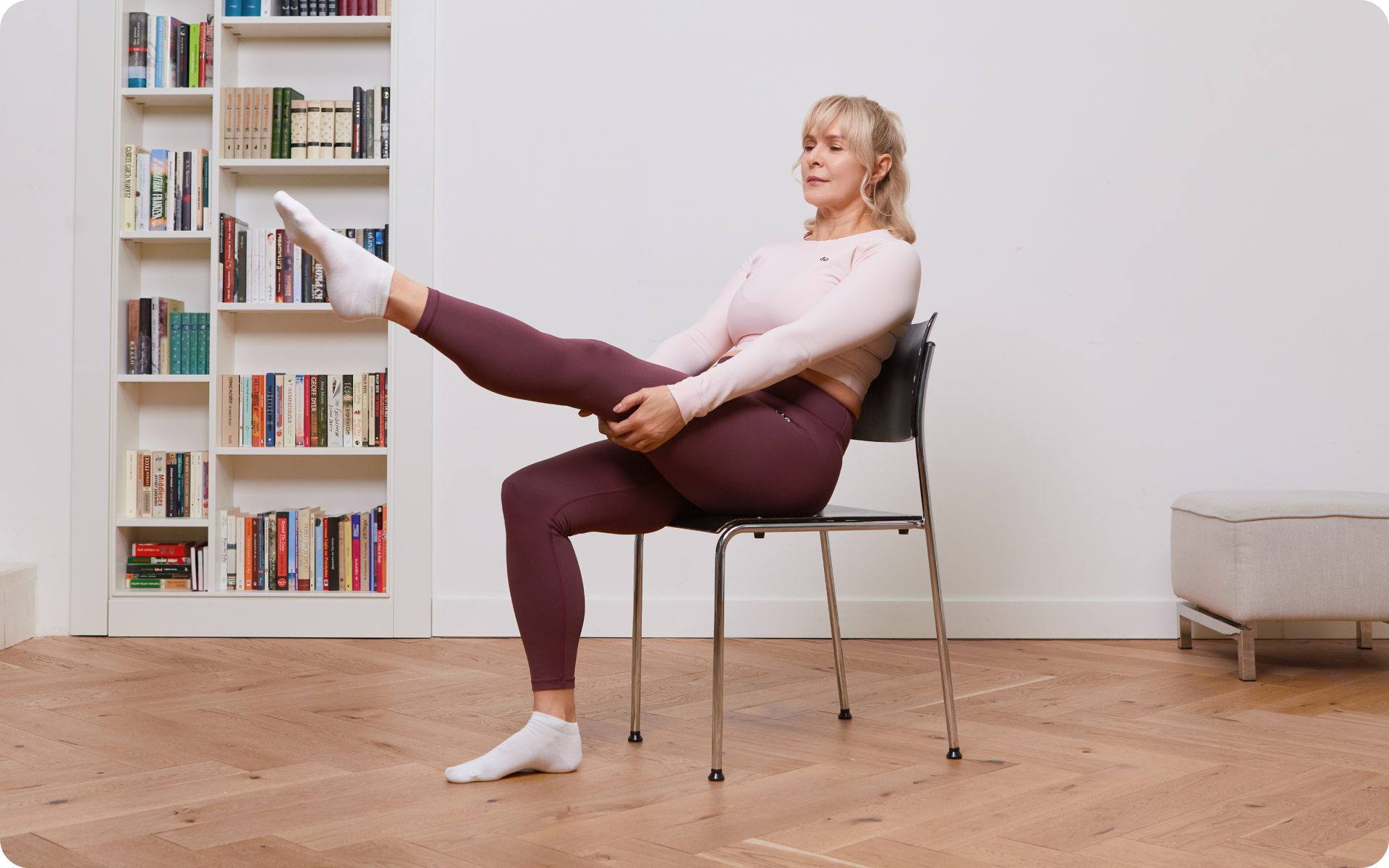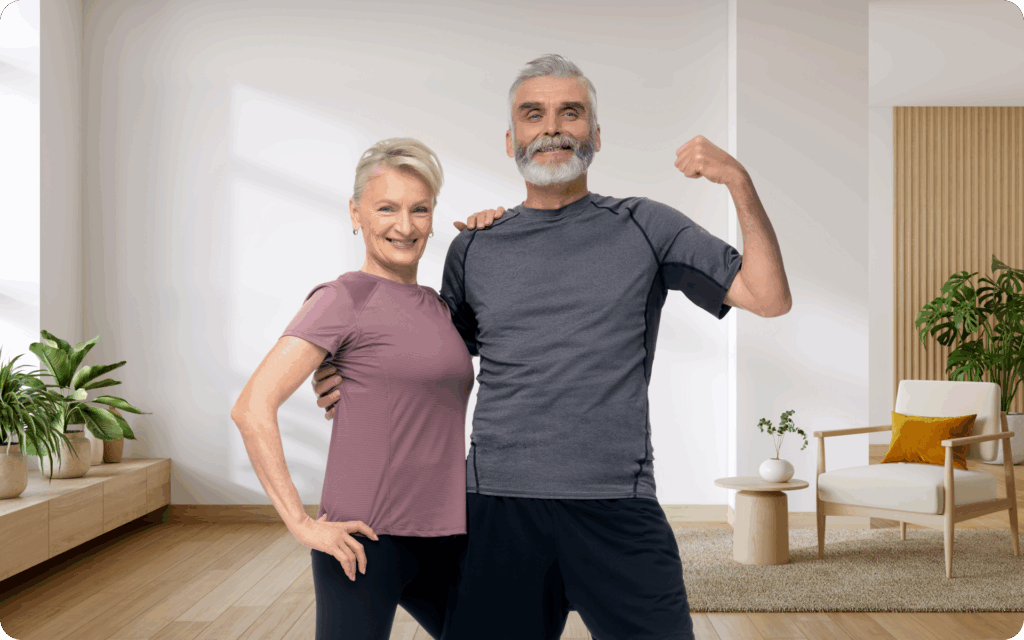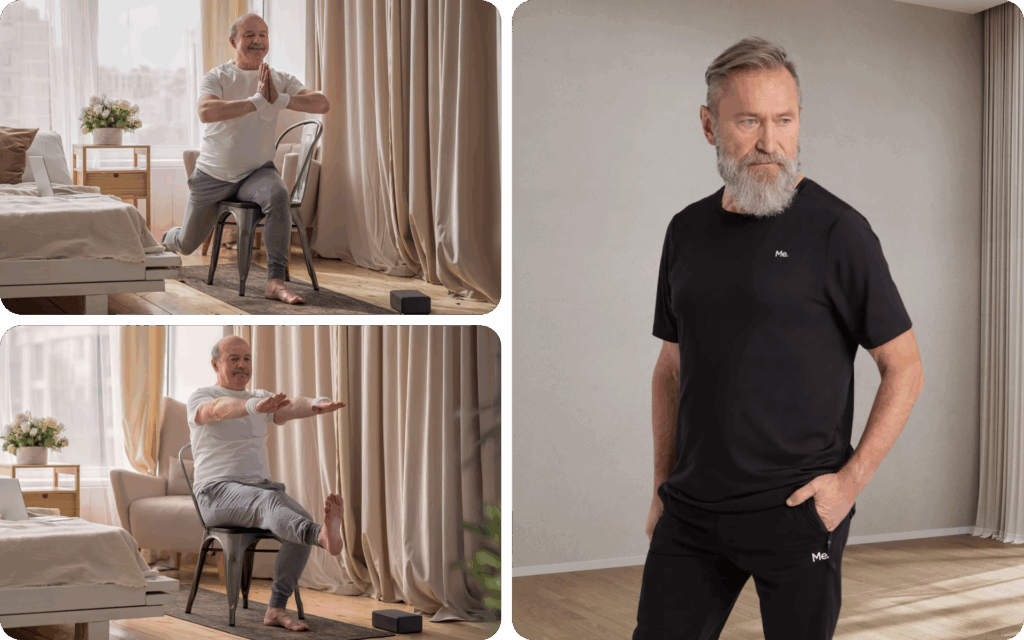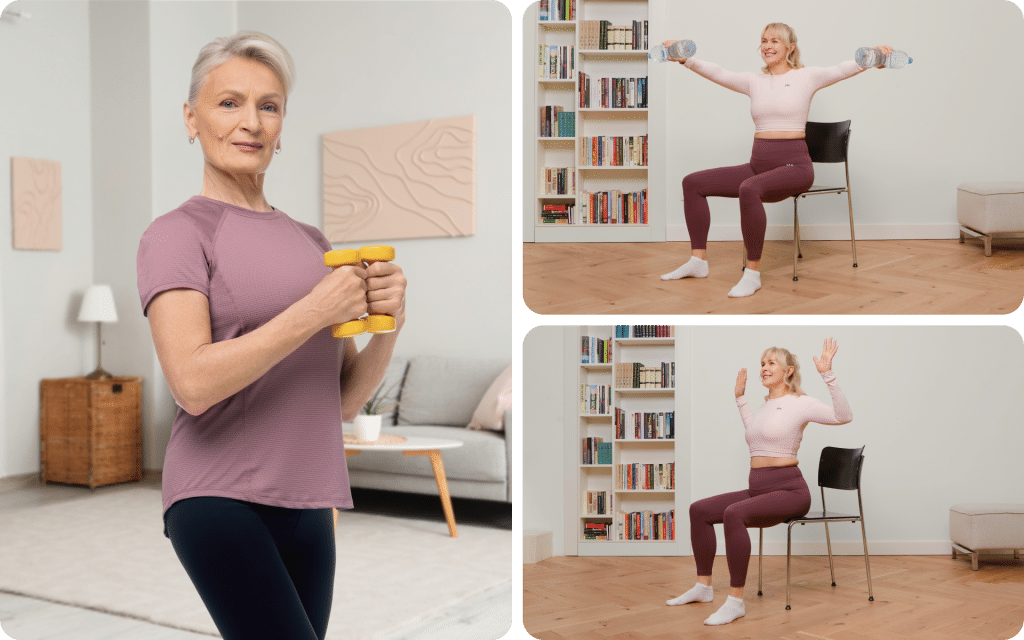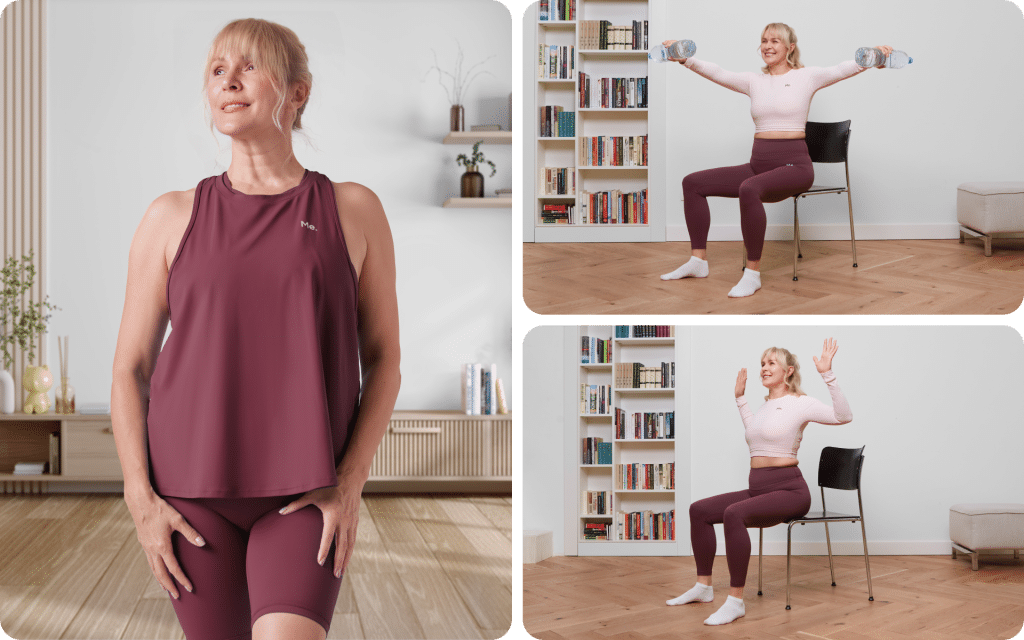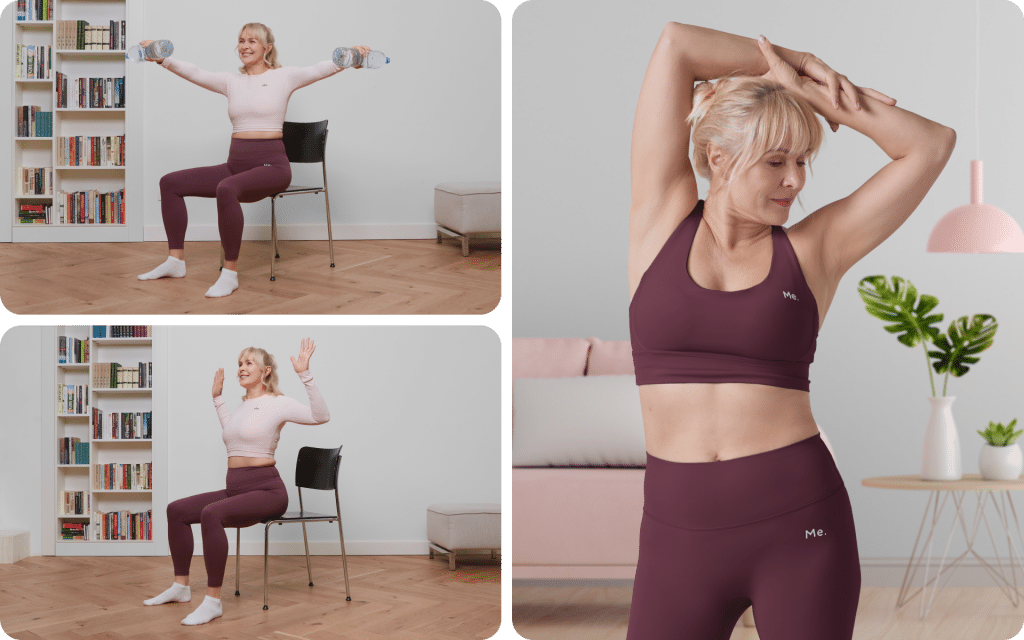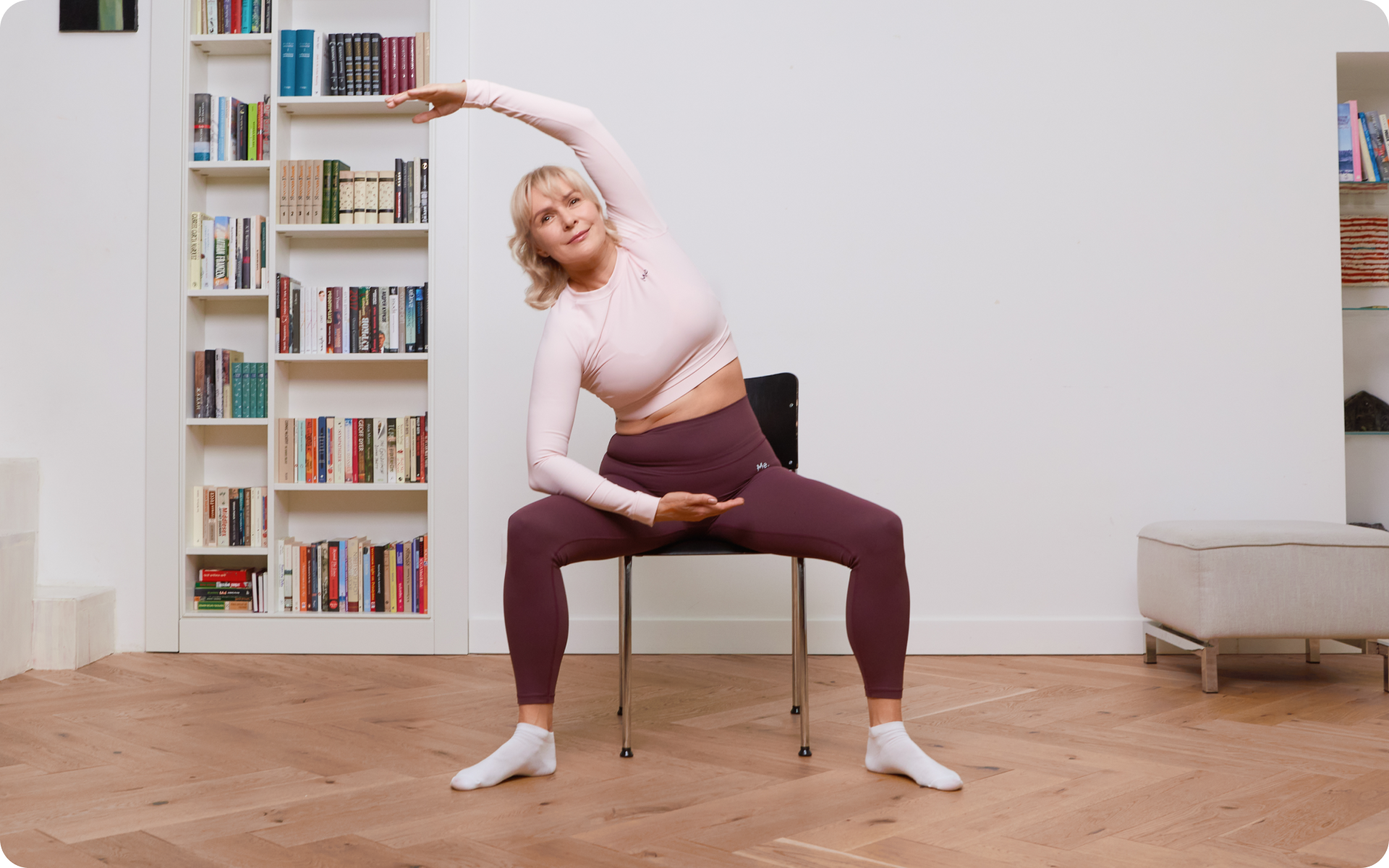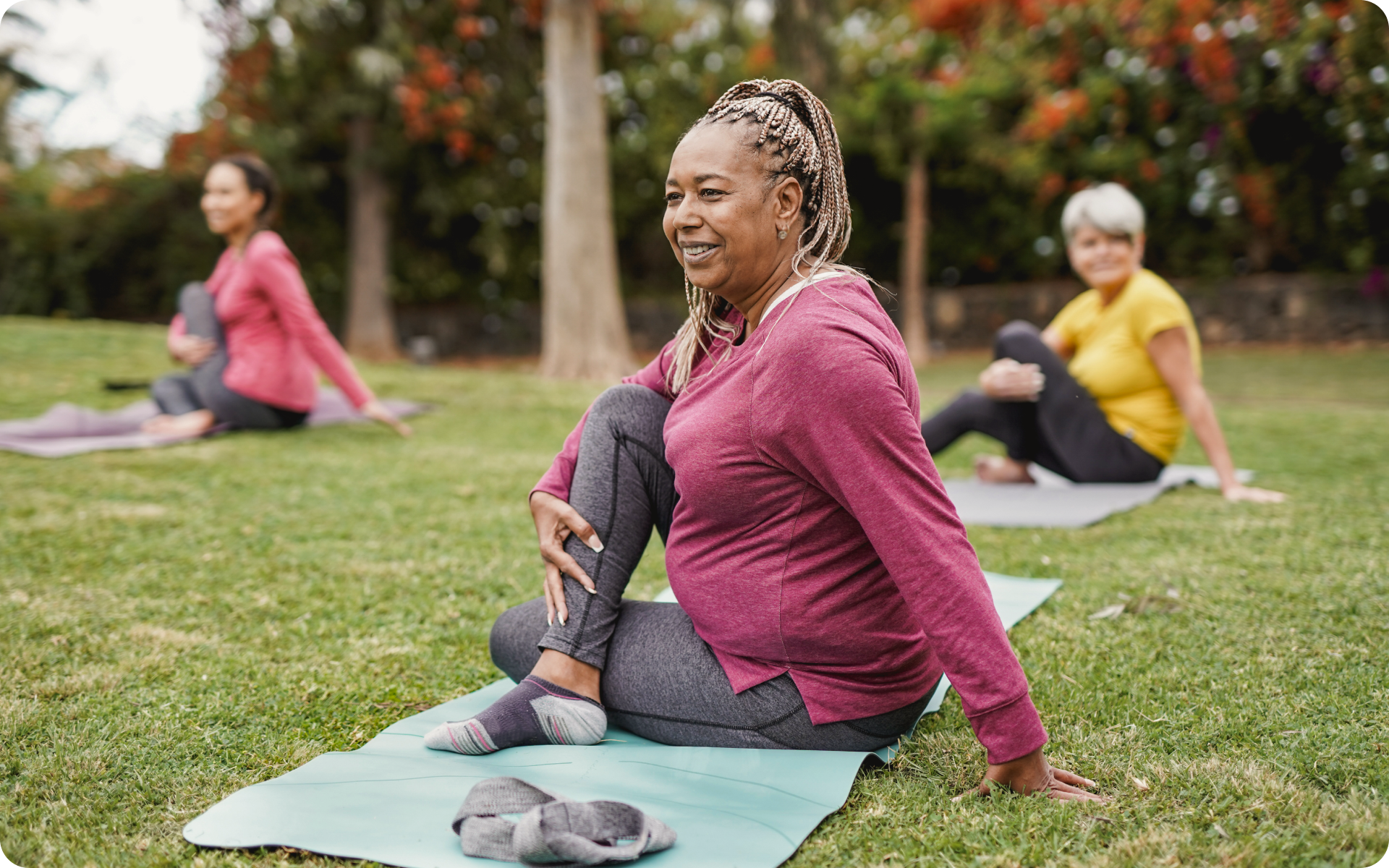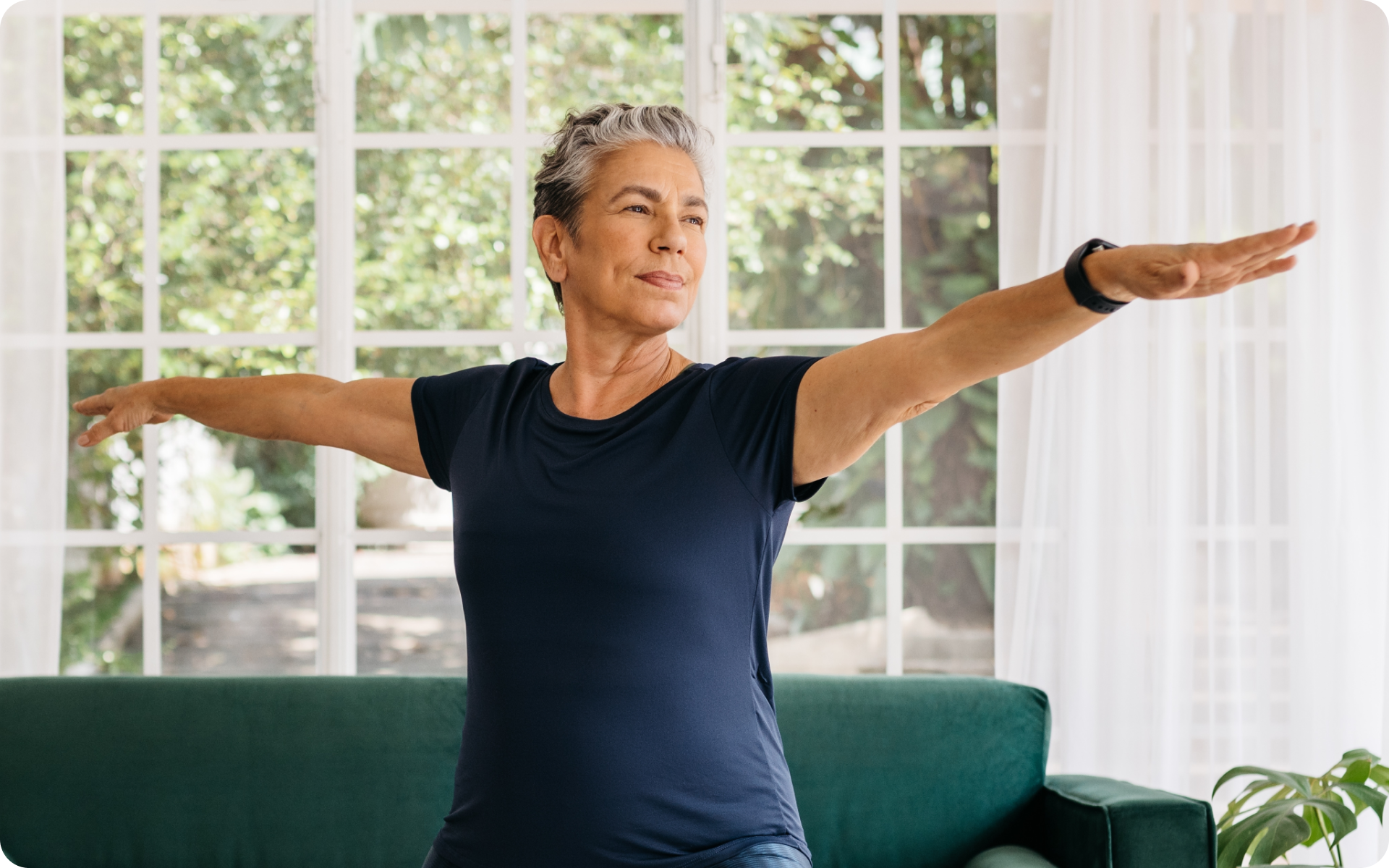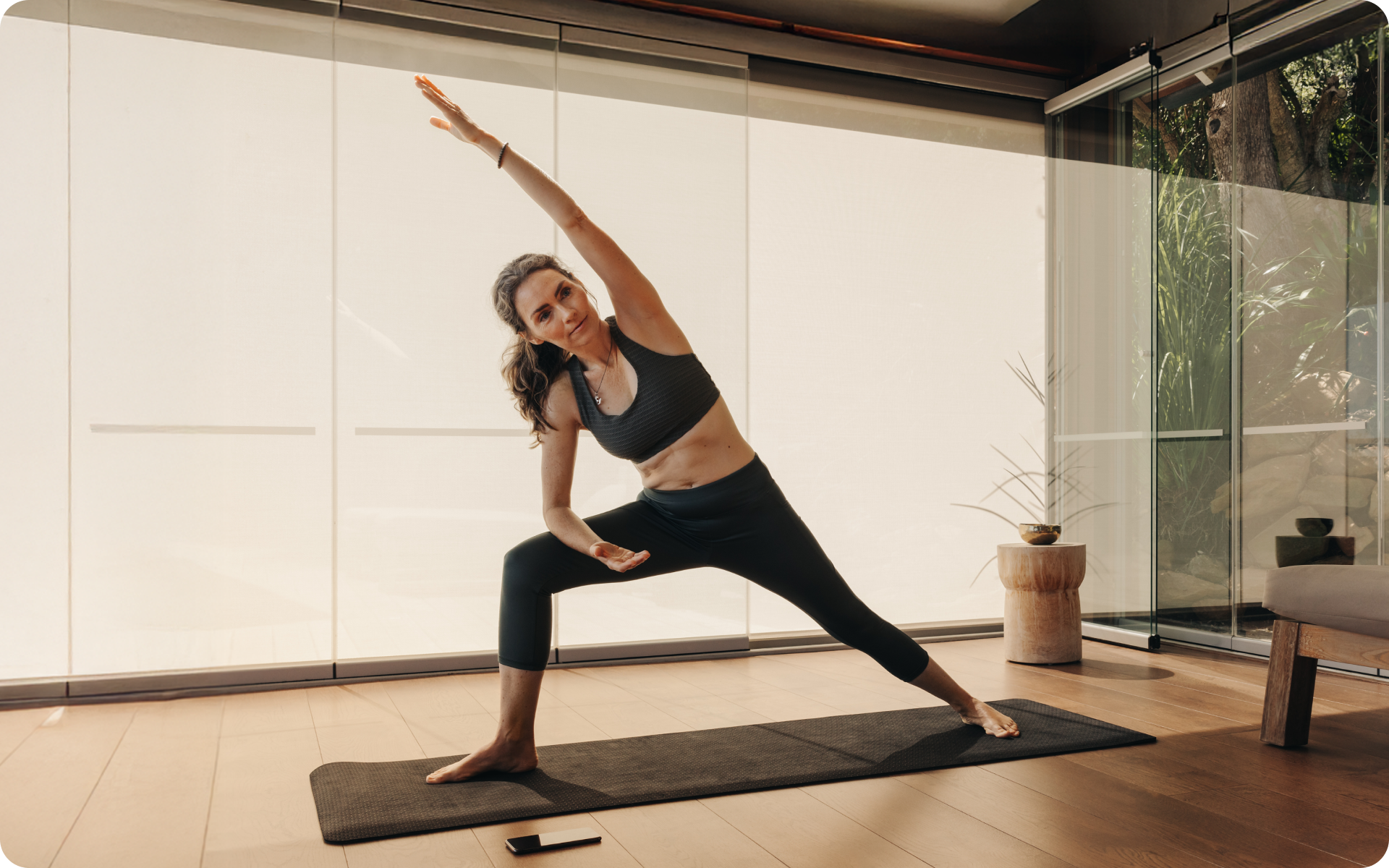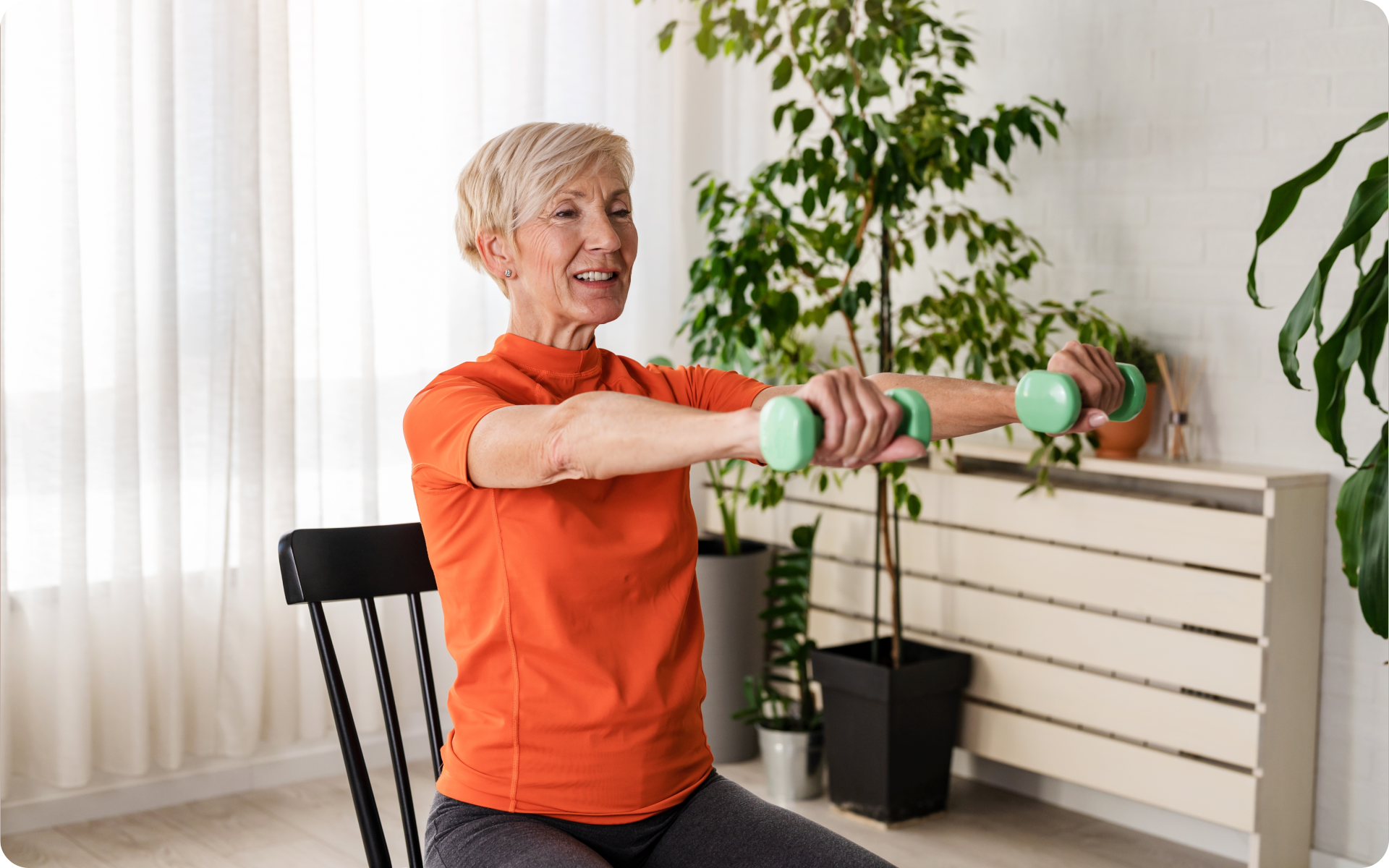Weight management can be a challenging topic for many seniors.
With age, your metabolism naturally slows down, making it more difficult to maintain or lose weight (1). In addition, factors such as reduced muscle mass, shifts in hormone levels, and age-related conditions often make traditional high-intensity workouts less practical or even unsafe (2).
Despite these complexities, remaining physically active is one of the most important pillars of good health for older adults (3).
Chair yoga, a modified style of yoga that is performed while sitting on or using a chair for support, is uniquely suited for older adults. It offers a low-impact way to move the body, improve flexibility, and engage muscles without placing excessive strain on joints or risking injury (4).
Chair yoga alone isn’t sufficient for significant weight loss, but it can support a broader weight management plan in various ways.
In this article, we explore how chair yoga can fit into a senior’s routine for weight loss and improved overall health. By understanding the benefits and practical applications of this gentle exercise, you can make informed choices about whether it’s the right option for you or a loved one.
What Is the Easiest Way to Lose Weight for Seniors?
Losing weight becomes more complex as you age, but it’s far from impossible. For seniors, the key lies in understanding the natural changes that occur with aging and adopting strategies that are aligned with these changes.
One of the primary challenges for seniors is a slower metabolism. Metabolism declines with age due to several changes in life (1, 5), including:
- Reduced muscle mass
- Lower activity levels
- Changes in hormone levels
Muscle is metabolically active tissue, which means the more muscle you have, the more calories your body burns at rest (6). As you lose muscle over time, your body burns fewer calories, which makes weight loss more difficult.
Another factor is that many seniors experience various ailments that limit their ability to engage in high-intensity workouts, including:
- Joint pain
- Reduced mobility
- Chronic conditions
These barriers can make traditional weight-loss advice, such as vigorous cardio or strict calorie cutting, feel unattainable or unsafe (7).
The BetterMe: Health Coaching app will provide you with a host of fat-frying fitness routines that’ll scare the extra pounds away and turn your body into a masterpiece! Get your life moving in the right direction with BetterMe!
Despite these challenges, there are effective and realistic steps seniors can take to lose weight safely and sustainably:
- Focus on Nutrient-Dense Eating
Instead of drastic calorie reduction, which can lead to muscle loss, prioritize a diet rich in lean protein, vegetables, fruits, whole grains, and healthy fats. Protein is particularly important as it supports muscle maintenance and repair (8). - Prioritize Strength Training
Incorporating strength training exercises is one of the most effective ways to combat muscle loss and boost metabolism (9). This doesn’t mean heavy weightlifting – bodyweight exercises, resistance bands, or light weights can all be effective. - Explore Low-Impact Activities
Gentle exercises, such as chair yoga, swimming, or walking, can help burn calories, improve mobility, and reduce the risk of injury. These activities are accessible for most seniors and can be adapted to suit individual needs (10). - Be Patient and Consistent
Weight loss for seniors tends to be gradual, and that’s okay. Aim for small, sustainable changes in your lifestyle instead of quick fixes. Losing even 5-10% of your body weight can have significant benefits for your health (11). - Leverage Mindfulness and Stress Management
Stress can make weight loss harder by increasing cortisol, a hormone that can lead to weight gain, particularly around the belly. Practices such as chair yoga or meditation can help seniors manage stress, improve sleep, and support better eating habits (12). - Stay Hydrated
Seniors are more prone to dehydration, which can sometimes be mistaken for hunger. Drinking enough water is a simple step that supports overall health and can curb unnecessary snacking (13).
The easiest way to lose weight for seniors isn’t a single “one-size-fits-all” solution. Instead, it’s about creating a balanced, sustainable routine that integrates manageable changes. By working with your body – not against it – it’s possible to reach and maintain a healthy weight, improve mobility, and boost overall wellness.
Read more: Yoga for Seniors at Home: 8 Gentle Exercises to Choose From
What Is the Best Yoga for Seniors to Lose Weight?
When it comes to yoga and weight loss for seniors, the “best” type of yoga is one that is aligned with your specific situation. Variables to consider include:
- Physical abilities
- Fitness and health goals
- Personal preferences and interests
For many seniors, this means focusing on styles that are gentle yet engaging. Luckily, there are several options to choose from with three popular options being:
- Chair yoga
- Restorative yoga
- Hatha yoga
Chair yoga is particularly well-suited for those with limited mobility, balance concerns, or joint pain. It makes yoga accessible, allowing participants to perform modified poses using a chair for support. This approach removes some of the physical barriers associated with traditional yoga, while still offering plenty of benefits (4).
Hatha yoga and restorative yoga also deserve mention as they emphasize slower, more deliberate movements. These styles can help seniors build flexibility and improve circulation while also honing mindfulness. Together, this supports healthier eating habits and reduces stress-related weight gain (14, 15).
Ultimately, the “best” yoga isn’t about following trends or choosing the toughest style. It’s about finding a practice that you enjoy and can sustain over time. Consistency is the key to seeing results and it’s easier to stick with something that feels manageable and rewarding.
Does Chair Yoga for Seniors Really Work for Weight Loss?
Chair yoga on its own isn’t a fast-track solution for weight loss, but it is an effective tool when it’s used as part of a well-rounded strategy. Weight loss occurs when the body burns more calories than it consumes, and physical activity plays a role in this equation (16). Chair yoga increases calorie expenditure by engaging muscles, enhancing mobility, and promoting circulation.
However, the benefits of chair yoga extend beyond calories burned. It encourages mindfulness, which can improve eating habits and make you more in tune with your body’s hunger and fullness cues. In addition, the stress-reducing effects of yoga can lower cortisol levels (17), a hormone that’s linked to fat storage, particularly around the abdomen (18).
For seniors who are starting their weight loss journeys, chair yoga is a fantastic entry point. It’s a safe and low-impact way to move your body, build strength and flexibility, and establish a routine that promotes overall health. While it won’t replace higher-intensity exercises for maximum calorie burn, it complements other activities such as walking or light strength training beautifully.
Is Chair Yoga Better than Regular Yoga for Seniors?
“Better” depends on the individual. Chair yoga and regular yoga each have their own benefits, and the ideal choice will depend on your unique needs and capabilities.
The benefits of chair yoga are ideal for seniors who suffer from various health conditions including;
- Mobility challenges
- Chronic pain
- Joint issues (i.e. arthritis)
Chair yoga removes the need to get down to the floor or hold weight-bearing poses that could strain your joints. This accessibility makes it an excellent choice for maintaining consistency without risking injury.
On the other hand, if a senior is physically able to perform mat-based poses, regular yoga may provide more variety and intensity. Practices such as hatha or yin yoga can still move at a slower pace to accommodate older adults, while more active styles such as vinyasa may appeal to those who want greater physical engagement.
The most important factor isn’t which type of yoga is “better”, but which is safer, more enjoyable, and sustainable. Many seniors may even find that combining both styles in their routines provides a well-rounded approach to fitness.
What Makes Chair Yoga for Seniors to Lose Weight Work?
The ability of chair yoga to support weight loss in seniors lies in its gentle yet effective approach to movement. Accommodating physical limitations enables seniors to remain active without fear of overexertion or injury, which is often a barrier to traditional fitness methods.
This form of yoga boosts physical activity by engaging muscles in gentle stretching and strengthening exercises. Over time, this can improve muscle tone and metabolism. In addition, chair yoga improves circulation, enhances mobility, and supports balance, which can make other forms of activity more manageable (17).
However, chair yoga doesn’t stop at physical benefits. It promotes mindfulness, improving awareness of eating habits and helping curb emotional eating. Its stress-relieving qualities can help regulate cortisol levels, making it easier to maintain a healthy weight (19).
What truly makes chair yoga work for weight loss isn’t that it burns the most calories, but that it’s accessible, adaptable, and sustainable. It helps seniors stay committed to an active lifestyle, which is often the biggest challenge when it comes to long-term weight management.
What Chair Yoga Exercise Burns the Most Belly Fat for Seniors?
No exercise, Chair Yoga to Lose Belly Fat included, targets abdominal fat directly. Fat loss occurs through a combination of overall body fat reduction, which comes from burning more calories than you consume and muscle engagement.
However, chair yoga can support this process by strengthening core muscles, improving posture, and promoting better mobility. Over time, these benefits enhance physical activity and contribute to a healthier, leaner body.
Below are six chair yoga exercises that help engage the abdominal muscles, increase flexibility, and promote calorie burning. To learn more about the chair exercises for belly, check out our in-depth article on the topic.
1. Seated Cat-Cow Stretch
This exercise gently improves spinal flexibility while activating the core muscles during transitions between extension and flexion.
Steps
- Sit upright in your chair with your feet flat on the floor and your hands resting on your knees.
- As you inhale, arch your back and lift your chest toward the ceiling, letting your belly stretch forward.
- Exhale as you round your back, drawing your belly button inward while tucking your chin to your chest.
- Repeat this movement slowly for 6-8 breaths.
2. Seated Oblique Twists
This movement strengthens the oblique muscles on the sides of the abdomen, helping with torso stability.
Steps
- Sit with your back upright and your feet firmly planted on the ground.
- Place your hands behind your head with your elbows pointing outward.
- On an exhale, twist your torso to the right, keeping your spine tall and your core engaged.
- Return to center and repeat on the left side.
- Perform 10-12 twists on each side.
3. Seated Knee-to-Chest Lifts
This exercise engages the lower abdominal muscles by lifting the legs, mimicking a seated version of a crunch.
Steps
- Sit on the edge of your chair, holding the sides for stability.
- Lean back slightly, keeping your spine straight and your core engaged.
- Lift your right knee toward your chest, then lower it slowly.
- Switch to the left knee and repeat.
- Perform 8-10 lifts on each side.
4. Chair Side Bends
This movement targets the obliques and improves lateral flexibility.
Steps
- Sit tall with your feet flat on the floor and your arms at your sides.
- Extend your right arm overhead while keeping the left hand on the chair for support.
- Gently lean to the left, feeling a stretch along your right side.
- Return to center and repeat on the opposite side.
- Perform 6-8 bends on each side.
5. Seated Toe Taps
This exercise engages the lower abs while promoting coordination and light movement to elevate your heart rate.
Steps
- Sit tall with your hands resting on your thighs.
- Lift your right foot slightly off the floor and bring it back down to tap the floor lightly.
- Alternate with your left foot, mimicking a marching motion.
- Continue for 30-60 seconds, maintaining a steady pace.
6. Seated Eagle Pose
This pose works both the core for balance and stability, while simultaneously allowing for an upper- and lower-body stretch.
Steps
- Sit tall and cross your right thigh over your left. If possible, hook your right foot behind your left calf.
- Extend your arms forward, crossing your left arm under the right, and intertwine your forearms.
- Pull your elbows up slightly while drawing your hands forward to stretch your shoulders and back.
- Engage your abdomen to maintain your seated posture. Hold for 3-5 breaths and repeat on the other side.
By incorporating these exercises into your routine, you’ll activate and strengthen the muscles in your core while enjoying the wider benefits of chair yoga.
Read more: 6 Yoga Poses for Older Women Who Are Looking to Increase Their Mobility
How Often Should You Do Chair Yoga for Seniors?
The frequency of chair yoga practice will depend on several variables:
- Individual goals
- Physical condition
- Overall activity levels
- Strength
- Balance
For most seniors, practicing chair yoga 2-4 times per week is an ideal starting point. This frequency allows enough repetition to see benefits in your overall health. This training frequency also allows the body plenty of time to rest and recover.
Whether you’re a workout beast or just a beginner making your first foray into the world of fitness and dieting – BetterMe has a lot to offer to both newbies and experts! Install the app and experience the versatility first-hand!
Factors That Influence Frequency
- Fitness Level
If you’re new to exercise, 2 sessions a week may be enough to start seeing benefits without overexerting yourself. More experienced individuals may wish to practice more frequently. - Health Conditions
Chronic conditions such as arthritis, osteoporosis, or cardiovascular concerns may require a more moderate approach. Work with a healthcare provider to determine a safe and suitable routine tailored to your needs. - Goals
If your aim is general mobility or relaxation, two sessions per week may suffice. For weight management or stronger core engagement, you may opt for more frequent sessions up to 4-5 times weekly.
Tips for Building a Sustainable Chair Yoga Routine
- Start Small
Begin with shorter sessions of 10-20 minutes, and gradually increase the duration as your endurance improves. - Be Consistent
Aim for steady progress by scheduling specific days and times for your practice. Consistency is more important than intensity. - Listen to Your Body
Avoid overexertion or practicing through pain. Rest when needed and ensure your body feels comfortable with each session. - Mix It Up
Combine chair yoga with other gentle activities such as walking or swimming to create a well-rounded fitness plan.
By practicing chair yoga regularly and balancing your sessions with rest and other forms of movement, you can foster a sustainable routine. Over time, this approach will enhance flexibility, strength, and overall well-being without placing undue stress on your body.
No exercise, including chair yoga, can target fat loss in a specific area of the body. Instead, fat loss occurs systemically when the body burns more calories than it consumes, and this process is influenced by a combination of activity levels, diet, and metabolism. That being said, chair yoga can help in several important ways. Many chair yoga exercises engage the core muscles, which include the abdominal muscles and surrounding stabilizers. Strengthening these muscles improves posture and balance while also enhancing overall functionality. While this muscle activity won’t directly burn belly fat, it can tone the area and make it appear leaner as overall fat is reduced through a comprehensive approach.Frequently Asked Questions
Can chair yoga reduce belly fat?
The Bottom Line
Chair yoga for seniors can help them lose weight. It’s a gentle, accessible, and highly adaptable exercise option that helps with physical activity and promotes mindfulness, stress reduction, and improved overall health. While it isn’t a quick fix for weight loss or specifically targeted toward belly fat, chair yoga supports sustained fat loss when it’s incorporated into a balanced lifestyle that includes healthy eating and other forms of movement.
DISCLAIMER:
This article is intended for general informational purposes only and does not serve to address individual circumstances. It is not a substitute for professional advice or help and should not be relied on for making any kind of decision-making. Any action taken as a direct or indirect result of the information in this article is entirely at your own risk and is your sole responsibility.
BetterMe, its content staff, and its medical advisors accept no responsibility for inaccuracies, errors, misstatements, inconsistencies, or omissions and specifically disclaim any liability, loss or risk, personal, professional or otherwise, which may be incurred as a consequence, directly or indirectly, of the use and/or application of any content.
You should always seek the advice of your physician or other qualified health provider with any questions you may have regarding a medical condition or your specific situation. Never disregard professional medical advice or delay seeking it because of BetterMe content. If you suspect or think you may have a medical emergency, call your doctor.
SOURCES:
- Metabolic changes in aging humans: current evidence and therapeutic strategies (2022, jci.org)
- Pilot study of a high-intensity interval training program in older adults: Safety, feasibility, functional fitness and cognitive effects (2024, pmc.ncbi.nlm.nih.gov)
- The Importance of Physical Activity Exercise among Older People (2018, onlinelibrary.wiley.com)
- Effect of Chair Yoga Therapy on Functional Fitness and Daily Life Activities among Older Female Adults with Knee Osteoarthritis in Taiwan: A Quasi-Experimental Study (2023, mdpi.com)
- Hormonal Regulators of Muscle and Metabolism in Aging (2009, clinicaltrials.gov)
- Increasing muscle mass to improve metabolism (2013, pmc.ncbi.nlm.nih.gov)
- Consequences of chronic diseases and other limitations associated with old age – a scoping review (2019, bmcpublichealth.biomedcentral.com)
- Protein Source and Muscle Health in Older Adults: A Literature Review (2021, mdpi.com)
- How can strength training build healthier bodies as we age? (2022, nia.nih.gov)
- What Counts as Physical Activity for Older Adults (2023, cdc.gov)
- Weight Loss and Improvement in Comorbidity: Differences at 5%, 10%, 15%, and Over (2017, link.springer.com)
- Impact of a stress management program on weight loss, mental health and lifestyle in adults with obesity: a randomized controlled trial (2018, pmc.ncbi.nlm.nih.gov)
- 10 Reasons Why Hydration is Important (2025, ncoa.org)
- Effects of Hatha yoga on cognitive functions in the elderly: a cross-sectional study (2022, pmc.ncbi.nlm.nih.gov)
- Restorative Yoga in Adults with Metabolic Syndrome: A Randomized, Controlled Pilot Trial (2008, pmc.ncbi.nlm.nih.gov)
- Fat Loss Depends on Energy Deficit Only, Independently of the Method for Weight Loss (2007, karger.com)
- Chair Yoga and Why Seated Yoga Poses Are Good For You (2023, brownhealth.org)
- Do stress reactions cause abdominal obesity and comorbidities? (2008, brownhealth.org)
- Effects of a chair-yoga exercises on stress hormone levels, daily life activities, falls and physical fitness in institutionalized older adults (2016, pubmed.ncbi.nlm.nih.gov)
